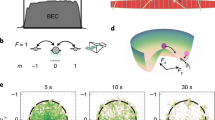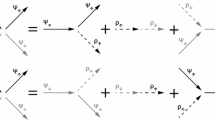Abstract
We investigate the influences of Dyson’s kinematic and dynamic interaction on the physical properties of two-dimensional quantum Heisenberg ferromagnet with O(3) rotational symmetry. It is found that the repulsive potential led by dynamic interaction modifies the third large term with \(T^{3}\) in the low-temperature series of specific heat. Under mean-field approximation, the kinematic interaction transforms the occupation-number configuration into a coherent-state configuration and significantly improves the result of modified spin wave theory in the high-temperature limit. In the low-temperature limit, the kinematic-interaction contribution to specific heat is negligibly small. For finite-size systems, it is found that a crossover temperature can be used to characterize the transition to a single-domain-type magnet. In the thermodynamic limit, the condensation factor (the number of zero-mode magnons) dominates the isothermal compressibility of magnon gas although there is not a real phase transition at finite temperatures. The asymptotic behavior of static structure factor depends on the relative size of the spin-wave wavelength with respect to the correlation length.
Graphic abstract






Similar content being viewed by others
Data Availability Statement
This manuscript has no associated data or the data will not be deposited. [Authors’ comment: All data included in this study are available upon request by contact with the corresponding author.].
References
N.D. Mermin, H. Wagner, Phys. Rev. Lett. 17, 1133 (1966)
M. Takahashi, Progr. Theor. Phys. Suppl. 87, 233–246 (1986)
M. Takahashi, Phys. Rev. Lett. 58, 168 (1987)
M. Takahashi, Jpn. J. Appl. Phys. Suppl. 26–3, 869 (1987)
M. Takahashi, Progr. Theor. Phys. 83, 815–818 (1990)
F.J. Dyson, Phys. Rev. 102, 1217–1230 (1956)
F.J. Dyson, Phys. Rev. 102, 1230–1244 (1956)
L.V. Popovich, M.V. Medvedev, Phys. Lett. A 247, 1856 (1998)
A. Auerbach, Interacting Electrons and Quantum Magnetism (Springer, Berlin, 1994), p. 187
D.P. Arovas, A. Auerbach, Phys. Rev. B 38, 316 (1988)
S.V. Maleev, JETP 6, 776 (1958)
C.P. Hofmann, Phys. Rev. B 86, 054409 (2012)
S. Tang, J.E. Hirsch, Phys. Rev. B 39, 4548 (1989)
S. Sarker, C. Jayaprakash, H.R. Krishnamurthy, M. Ma, Phys. Rev. B 40, 5028 (1989)
P. Kopietz, S. Charavarty, Phys. Rev. B 40, 4858 (1989)
A. Chubukov, Phys. Rev. B 44, 12318 (1991)
F. Suziki, N. Shibata, C. Ishii, J. Phys. Soc. Jpn. 63, 1539 (1994)
I.S. Gradshteyn, I.M. Ryzhik, Table of Integrals, Series, and Products, 7th edn. (A&P, New York, 2007), p. 860
Acknowledgements
This work was supported by NSFC (Grant no. 61565013).
Author information
Authors and Affiliations
Contributions
The author (BX) is responsible for the whole content of the paper.
Corresponding author
Appendices
Appendix A: Properties of \(f_{L}(x)\)
Equation (6) in the text defines function \(f_{L}(x)\) with non-negative integer L
where, \(\Gamma (z)\) is the Gamma-function. The n-order derivative of \(f_{L}(x)\) with respect to x satisfies the following recurrence relation
Appendix B: Coherent state configuration
In the occupation-number configuration, the trace in the partition function can be rewritten as
The new states read as
where
with \(-1< D <0\). The absent normalization factor \(A_k\) in the above expression can be determined from \(\left\langle \Omega _k|\Omega _k\right\rangle =1\) and leads to
It is noticed that the kinematic interaction under mean-field approximation maps the occupation-number configuration onto a coherent-state configuration. The mean-field approximation completely suppresses the fluctuations in momentum space, which corresponds to a common chemical potential shared by all \(\mathbf {k}\)-states.
Appendix C: Solution to the saddle-point equations
In deducing the saddle-point Eq. (22), the following relation is used
where,
\(\frac{ \partial D }{ \partial \Delta }\) is the first-order partial derivative of D with respect to \(\Delta \) and explicitly written as
Since the expression in the round bracket is never equal to zero, equation \(\frac{ \partial D }{ \partial \Delta }=0\) has the unique solution \(\Delta = 0\) while \(L>1\).
Appendix D: Density of state
Using the following equation
where K(x) is the complete elliptic function of the first kind [18]. The density of state reads
One can expand K(x) in terms of small x as
and obtain Eq. (38) in the text.
Appendix E: Magnetic susceptibility
The correlation function with \(i\ne j\) can be written as
For the case with \(i= j\), \(\mathbf {S}_i\cdot \mathbf {S}_j =S(S+1)\). The magnetic susceptibility reads
The second expression uses the symmetrization of correlation function for the Heisenberg systems with O(3) symmetry.
Appendix F: Integral formula used in calculating the static structure factor
According to the integral formula
the equation (85) reduces to
where
Introducing the following parameter
and using the integral formula
we obtain the expression (86) in the text.
Rights and permissions
About this article
Cite this article
Xu, B. Kinematic interaction and condensation factor in two-dimensional quantum Heisenberg ferromagnet. Eur. Phys. J. B 94, 5 (2021). https://doi.org/10.1140/epjb/s10051-020-00041-3
Received:
Accepted:
Published:
DOI: https://doi.org/10.1140/epjb/s10051-020-00041-3




